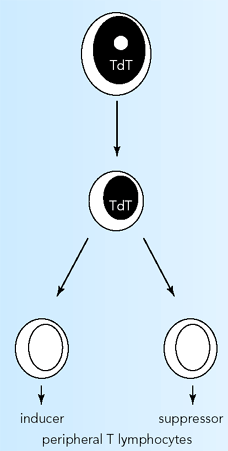14 - The Ear and Temporal Bone
Editors: Mills, Stacey E.
Title: Histology for Pathologists, 3rd Edition
Copyright 2007 Lippincott Williams & Wilkins
> Table of Contents > VI - Thorax and Serous Membranes > 19 - Thymus
function show_scrollbar() {}
19
Thymus
Saul Suster
Juan Rosai
Introduction
The thymus is a prototypical lymphoepithelial organ. As such, it is composed of intimately admixed epithelial and lymphoid elements that act in concert to perform their assigned roles. In addition, the thymus harbors other cellular constituents, such as a variety of mesenchymal-derived elements, scattered neuroendocrine cells, and presumably germ cells, all of which may take part in the development of neoplastic and nonneoplastic processes of this organ. Although much progress has been made in the immunohistochemical characterization of the cellular components of the thymus, the diagnosis of thymic lesions still remains largely dependent on the light microscopic interpretation of the findings by the pathologist.
Embryology
The thymus is derived from the third and, to a lesser extent, the fourth pharyngeal pouches, which contain elements derived from all three germinal layers. During the sixth week of gestation, the endodermal lining of the ventral wing of the third pharyngeal pouch forms a pronounced sacculation, which subsequently detaches from the pharyngeal wall, giving rise to the thymic primordia (1,2). It is postulated that, at approximately the same time, the cervical sinus (an ectodermal structure that results from the fusion of the second, third, and fourth branchial clefts) attaches to the thymic primordia, investing them with a layer of ectodermal cells (1,3). As development continues, the thymic primordia migrate in a caudal and medial direction along with the lower parathyroid glands. During the eighth week, these primordia enlarge toward their lower ends, forming two epithelial bars that fuse along the midline to occupy their definitive position within the anterosuperior mediastinum. During this descent, the tail portion of the organ becomes thin and elongated and breaks up into small fragments that usually disappear but that may persist in the soft tissues of the neck, often in intimate connection with the lower parathyroid gland and sometimes embedded within the thyroid gland (see section on Developmental Abnormalities) (1,4).
P.506
After migration has been completed, the thymic endodermal-derived epithelial cells develop into stellate elements, forming a reticular meshwork. The surrounding mesenchymal elements form a capsule around it; and, as a result of ingrowth of the capsule, trabeculae form that divide the organ into numerous lobules. By the tenth week, small lymphoid cells originating in the fetal liver and bone marrow populate the thymus, and the organ differentiates into a cortex and a medulla (5). Small, tubular structures composed of epithelial cells (sometimes referred to as medullary duct epithelium) also make their appearance at this time and later give rise to Hassall's corpuscles (6). The thymus progressively enlarges until puberty and from then on begins to involute, although persisting in an atrophic state into old age.
Developmental Abnormalities
Disturbances in the embryologic development of the thymus may give rise to a series of congenital anomalies. One of the anomalies most frequently encountered is the presence of parathyroid gland tissue within the thymus (7) (Figure 19.1). Such ectopically located tissue is most frequently encountered within the thymic capsule or in close proximity to it (8). This abnormality is easily explained by the close developmental relationship that exists between the two organs, as described in the section on embryology. The thymus itself also may be found in ectopic locations; this usually results from failure of the organ to migrate to its final destination during embryonic development. Undescended thymuses most often are located in the lateral neck, in close association with or even buried within the parathyroid or thyroid glands (9). These rests have a tendency to undergo cystic changes (9). They also may give rise to thymomas, ectopic examples of which have been described in submandibular (10), paratracheal (11,12), and intratracheal locations (13), as well as within the thyroid gland (14,15). A morphologically distinctive lesion of the thymus displaying combined features of neoplasia and hamartoma occurring in the lower neck has also been recognized (16). Ectopic nodules composed of thymic tissue have been reported in several other locations, including the base of the skull (17) and the pulmonary hilus at the root of the bronchus (18).
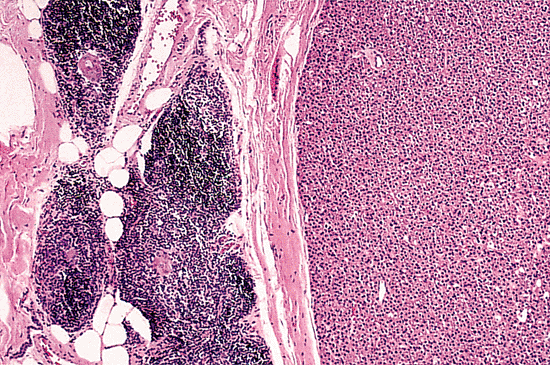 |
Figure 19.1 Ectopic parathyroid tissue adjacent to normal thymus. |
Ectopic sebaceous glands have been reported in the thymus (19) and are felt to be related to the contribution of the ectodermally derived cervical sinus to the developing thymus. Mature-appearing salivary gland tissue also may be present in the thymus (Figure 19.2) and has been reported as a component of an intrathoracic cyst that contained normal thymus and parathyroid tissue within its walls (20). It was postulated that this finding could be related to a developmental malformation whereby salivary gland anlagen had been incorporated into the uppermost portion of the third pharyngeal pouch during embryogenesis.
Morphologic abnormalities of the thymus characterized by an embryonal appearance, with a predominance of small spindle epithelial cells adopting a lobular configuration and lacking small lymphocytes and Hassall's corpuscles, have been observed in association with combined immunodeficiency syndromes and T-cell defects (21). Such morphologic alterations have been termed thymic dysplasias and are believed to represent disturbances of normal development. In conditions such as reticular dysgenesis, Swiss-type hypogammaglobulinemia, thymic alymphoplasia, and ataxia-telangiectasia, the immune deficit is accompanied by aplasia or hypoplasia of the thymus (22,23,24). In DiGeorge syndrome, which is believed to result from an arrest in development of the third and possibly fourth branchial arches, there is a vestigial but normal thymus associated with absence or hypoplasia of the parathyroid glands (25). In Nezelof syndrome (26), the thymic abnormality is similar to that of DiGeorge syndrome except that the parathyroids are normal. The failure of development is thus thought to involve only that part of the branchial endoderm that will
P.507
differentiate into thymic epithelium. Histologic changes in the thymus similar to those of thymic dysplasia of primary immunodeficiency disease have been observed in infants as a consequence of graft-versus-host disease after blood transfusions (27). A case of congenital aplasia of the parathyroid glands and thymus in the newborn also has been described (28). The term thymic dysplasia in the setting of immunodeficiency conditions may be misleading because of its currently accepted connotation as a preneoplastic cellular status. The alterations in such conditions are unrelated to a neoplastic etiology.
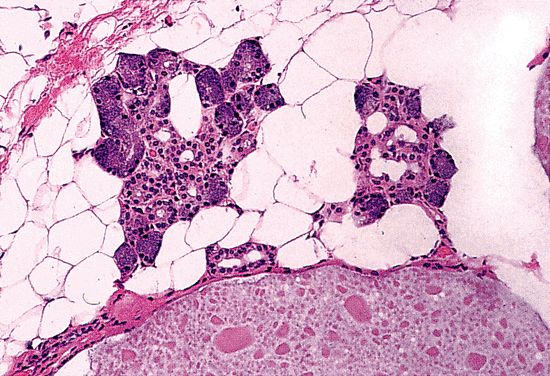 |
Figure 19.2 Mature-appearing salivary gland acini are seen adjacent to cystically dilated Hassall's corpuscle. |
Apoptosis
Apoptosis is the name that has been given to the process of physiologic (programmed) cell death. Most thymic lymphocytes die in situ by such a process. During T-cell ontogeny in the thymus, the T cells (T lymphocytes) may undergo a process of positive or negative selection. The accumulated evidence appears to support that apoptosis plays a major role in the process of negative selection and that the vast majority of cortical thymocytes die by this mechanism. Autoreactive thymocytes or harmful cells in the thymus with injured DNA or alterations of their metabolism are also thought to be eliminated by the process of apoptosis at a specific stage of their differentiation (29,30). Therefore, it is believed that disturbances of the apoptotic process within the thymus can be responsible for the appearance of autoreactive cells in the circulation that may give rise to the development of autoimmune disease. In addition, failure of apoptosis also may play a role in carcinogenesis. On the other hand, massive induction of apoptosis within the thymus may lead to immunodeficiency as a result of a decrease in the number of lymphocytes. Thus, thymocyte apoptosis plays an integral role in the pathophysiology of the immune system.
The exact biochemical mechanism involved in thymocyte apoptosis has not yet been completely elucidated; however, it is known that various complex physiologic and nonphysiologic mechanisms can induce it (31). This has led many investigators to seek the genes and their products that are necessary for apoptosis. Several groups have noted that messenger RNA (mRNA) levels for various proteins are increased early in thymocytes after treatment with glucocorticoids or radiation, two agents known to induce massive apoptosis of cortical thymocytes (32,33). A number of genes also have been identified whose expression is increased in cells undergoing apoptosis. Among them, three proto-oncogene products have been shown to act as important regulators of the apoptotic process in mammals: c-myc, bcl-2, and p53. In thymocytes, bcl-2 mRNA is present in the surviving mature thymocytes of the medulla and also in most immature (CD4+/CD8+) thymocytes, although the majority of cortical thymocytes (most of which die by apoptosis) display no bcl-2, suggesting that this oncogene may be involved in the preservation of T cells (34). Alterations of the p53 gene also have been shown to play a role in the process of thymocyte apoptosis. Malfunction of the tumor suppressor gene p53 may promote carcinogenesis by permitting mutated cells to duplicate their DNA before it is repaired. In mice, p53-deficient thymocytes have been shown to display drastic resistance to the apoptotic effects of radiation (35). The latter observation suggests that the integrity of the p53 gene, whose product is known to arrest cell proliferation, may be necessary for the normal apoptotic process in the thymus.
Another pathway of thymocyte apoptosis that has been the object of close scrutiny is the role of the T-cell receptor (TCR)/CD3 complex in this process. During thymocyte development, rearrangement of TCR genes leads to expression of unique, clonally expressed TCRs. Potentially autoreactive thymocytes bearing TCRs with high avidity for self undergo TCR-mediated, activation-induced apoptosis (negative selection), whereas thymocytes with TCRs of low avidity survive (positive selection) (36,37). Recent experiments have demonstrated that the activation of the TCR/CD3 complex leads to the preferential elimination of immature (CD4+/CD8+) thymocytes (38). These and other studies have demonstrated that TCR-mediated signals are involved in apoptosis, and this phenomenon is strongly related to the mechanism of negative selection, although the precise in situ mechanism of apoptosis has not yet been elucidated (39,40).
Anatomy
The fully mature human thymus is an encapsulated midline structure predominantly located in the anterosuperior mediastinum and composed of two lobules joined in the midline by loose connective tissue and thymic parenchyma. The base of the organ lies on the pericardium and great vessels. The upper poles of each lobe extend into the lower neck and are closely applied to the trachea. The lower poles extend down over the pericardium for a variable distance, generally up to the level of the fourth costal cartilage. The anterior border of the gland is made up by the cervical fascia, strap muscles of the neck, sternum, costal cartilages, and intercostal muscles, and the lateral borders are covered by reflections of the parietal pleura.
The size and weight of the gland may vary considerably depending on the age of the person, although wide variations among individuals in the same age group have been observed (41). The mean weight at birth is about 20 g. The organ exhibits a continuous growth in size until puberty, when it reaches a mean weight of approximately 35 to 50 g; thereafter, it undergoes atrophy, as manifested by a decrease in weight and volume and progressive fatty replacement of the parenchyma.
The blood supply of the organ is derived from the internal mammary, superior and inferior thyroid arteries, and,
P.508
to a lesser degree, the pericardiophrenic arteries. The arterial branches course along fibrous septa to the region near the corticomedullary junction, where they branch into the cortex and the medulla. The capillaries descend from the outer cortex toward the medulla to form postcapillary venules, and they exit the thymus through the septa as interlobular veins. The venous system drains into the left brachiocephalic, internal thoracic, and inferior thyroid veins. There are no true thymic intraparenchymatous afferent lymphatics. Lymph vessels arise in the interstitium of the lobular septa and merge to form large lymph vessels that course alongside the arteries in the septa. The innervation of the organ is derived from branches of the vagus nerve and the cervical sympathetic nerves.
Histology
The basic structural unit of the thymus is the lobule. Each lobule is composed of two morphologically distinctive areas, the cortex and the medulla, both of which are largely composed of varying proportions of epithelial cells and thymic lymphocytes (thymocytes) (Figure 19.3). In the cortex, the sparse epithelial cells present are overshadowed by the numerous, closely packed small lymphocytes. The medulla, in contrast, contains a larger number of epithelial cells and fewer lymphocytes. The cortex and the medulla combined correspond to the thymic epithelial compartment, which is the site of T-cell maturation within this organ. Another important anatomic compartment of the thymus is the perivascular space. In the mature infant thymus, the perivascular space represents a virtual space containing thymic blood vessels and corresponding to a portion of tissue that is contained within the capsule but outside of the thymic epithelial network (42). The perivascular space becomes more prominent with aging and in pathologic processes such as thymoma, and eventually it is replaced with fat and lymphocytes in the involuted thymus of the adult (43). In addition to the epithelial and perivascular space compartments, there is also a stromal compartment that harbors a variety of other cell types. A thin fibrous capsule is generally present surrounding the entire gland. The interplay of these various cellular elements and compartments contributes to define the various organotypical features of the normal thymus.
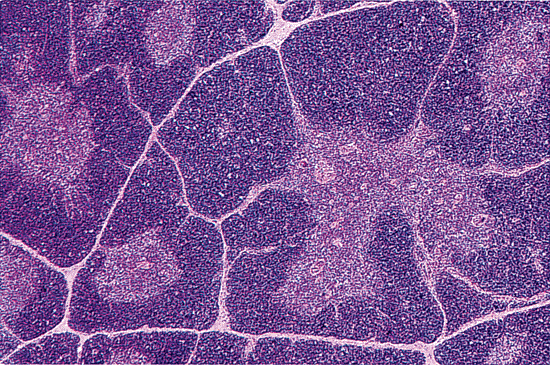 |
Figure 19.3 Normal lobular architecture of the thymus demonstrating clear separation between cortex and medulla. |
One of the problems involved in defining the normal thymus is that the histologic appearance of the organ shows progressive changes over time, depending on its stage of maturation or involution. Thus, the normal thymus of the adult will look quite different from the normal thymus in a child or adolescent. Studies by Hale (43) have shown that the thymus gland does not actually decrease in size or alter its shape over time with the normal process of involution. While the overall size and shape of the gland is retained throughout adulthood into old age, the various cellular constituents are replaced as the normal process of functional involution takes place. Thus, in the thymus of the adult and old age, the normal thymopoietic elements represented by the epithelial compartment become reduced and progressively disappear, being gradually replaced by mature adipose tissue. Residual epithelial elements, however, always remain and generally undergo a process of atrophy that results in a change in the shape of the cells from large, round cells with vesicular nuclei and abundant cytoplasm to small, oval to spindle-shaped cells with hyperchromatic nuclei and scant cytoplasm (44). Small, microscopic, thymopoietic remnants of thymic epithelium can also be found, which usually retain the normal architecture and appearance of the mature cortex in childhood. Other involutional changes include the formation of cystic structures, usually resulting from dilatation of residual Hassall's corpuscles, and the formation of small, abortive glandular or epithelial rosette-like structures within the lymphopoietic islands.
The most distinctive organotypical features of the mature thymus of childhood and adolescence thus include a fibrous capsule, a lobular architecture with sharp separation between the cortex and the medulla, a dual cell population characterized by an admixture of large, round thymic epithelial cells with immature T-cells, and perivascular spaces. The organotypical features of the normal involuted thymus of the adult, on the other hand, include the presence of small, spindle-shaped thymic epithelial cells, abundant cystic structures and rosette-like epithelial structures, and the paucity of immature T-cells. Needless to say, these features represent a continuum that will be manifested in various proportions depending on the age, functional status of the organ, various physiologic conditions, and disease states affecting the thymus.
Epithelial Cells
The epithelial cells of the thymus have traditionally been divided into cortical and medullary; some of the latter are arranged in round keratinized structures known as Hassall's
P.509
corpuscles. In the active thymus of infancy, most epithelial cells are plump, with round or oval nuclei. Their cytoplasm (particularly in the case of the cortical cells) is endowed with numerous prolongations that join with those of adjacent cells to form a veritable network or reticulum. This feature (rather than the relationship with reticulin fibers or presumptive embryologic origin) has led to the previous designation of reticuloepithelial cells. These various epithelial elements play an active role in promoting T-cell maturation in the thymus, either through the action of their humoral substances or through direct contact with thymocytes (45).
A subset of thymic epithelial cells that have predominantly localized to the cortex has been designated as nurse cells. They are characterized by having an abundant cytoplasm within which are engulfed numerous mature thymic T cells. A ringlike staining pattern has been observed in these cells with antiepithelial cell antibodies by immunohistochemistry on sections of human thymus (46). It has been postulated that nurse cells may provide a specialized microenvironment for T-cell maturation, differentiation, and selection in the thymus (46,47).
Hassall's Corpuscles
Hassall's corpuscles constitute the most readily identifiable feature of the thymus at the light microscopic level. They are restricted to the medulla and are characterized by a concentric pattern of keratinization, the keratin formed being of high-molecular weight (epidermal) type (Figure 19.4). These structures may show much variation in their morphologic appearance, mainly as a result of reactive changes secondary to inflammation. This includes cystic degeneration with accumulation of cellular debris, dystrophic calcification, and infiltration by lymphocytes, foamy macrophages, and eosinophils (Figure 19.5). The
P.510
thymic lesions known as Dubois's microabscesses and traditionally ascribed to congenital syphilis (48) represent an exaggeration of the cystic changes in Hassall's corpuscles as a result of infection. We believe that most so-called multilocular thymic cysts are not congenital abnormalities but rather the result of cystic enlargement of Hassall's corpuscles on the basis of acquired inflammatory changes in this organ (49). An additional change that can be seen in relation to cystic Hassall's corpuscles is the presence of glandular elements, as manifested by the appearance of columnar epithelium (sometimes ciliated- or of goblet-cell type) and the secretion of sulfated acid mucopolysaccharides in the lumen (50). It is likely that these glandular changes are related to the embryologic origin of Hassall's corpuscles (6).
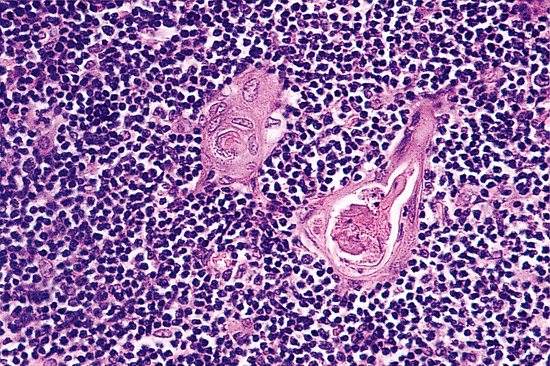 |
Figure 19.4 Normal Hassall's corpuscles showing characteristic concentric arrangement of keratinizing epithelial cells. |
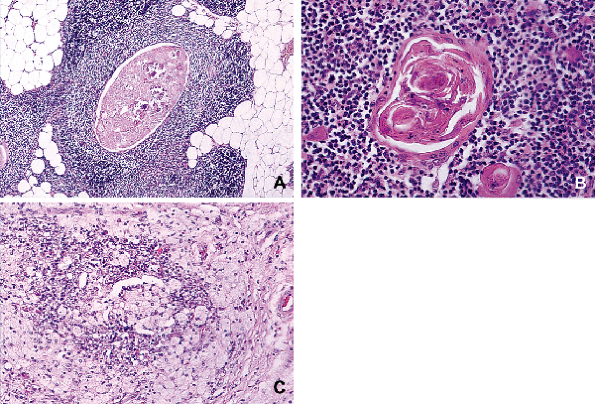 |
Figure 19.5 Hassall's corpuscles showing (A) cystic dilatation with accumulation of cellular debris, (B) dystrophic calcification, and (C) accumulation of foamy macrophages. |
Thymic Lymphocytes (Thymocytes)
The predominant cell population of the thymic cortex is made up of lymphocytes that may be large, medium, or small. Large, mitotically active lymphoblasts comprise about 15% of the lymphoid cells and are found predominantly in the subcapsular portion of the outer cortex (51). These lymphocytes have a round or oval (occasionally convoluted) nucleus, one or two prominent nucleoli, and relatively abundant, strongly basophilic cytoplasm. A gradient of smaller, less mitotically active cells occurs from the outer cortex to the corticomedullary junction and to a lesser degree into the medulla of the normal thymus (Figure 19.6). In the capsular region and deep cortex, the vast majority of thymic lymphocytes are short-lived and die in situ (52). This results in lympholysis and active phagocytosis, features that impart these areas with a prominent starry sky appearance and that become particularly prominent in accidental (stress) thymic involution (see section on Thymic Involution) (Figure 19.7).
 |
Figure 19.6 Normal thymic cortex. There are numerous cortical thymocytes, most of which have small nuclei with densely packed chromatin. |
 |
Figure 19.7 Prominent starry sky appearance in the deep cortex of patient with accidental thymic involution. Note abundance of tingible-body macrophages (inset). |
Other Cell Types
In addition to epithelial cells and lymphocytes of T-cell lineage, the thymus contains an array of additional cell types. The first of these, B cells (B lymphocytes), can be found aggregated as lymphoid follicles or scattered as individual cells. Lymphoid follicles with active germinal centers may be found in otherwise normal thymuses, especially in children and adolescents (Figure 19.8) (52,53). The presence of such B-cell structures would seem difficult to reconcile with the fact that the thymus constitutes a predominantly T-cell organ. However, ultrastructural studies have indicated that germinal centers in the thymus arise within perivascular spaces, the latter being clearly separated from the thymic parenchyma by a basal lamina (54). This observation led to the proposal that the thymus may be divided into two major functional compartments: (a) the cortex and medulla (which constitute the true thymic parenchyma) and (b) the
P.511
extraparenchymal compartment composed of the perivascular spaces (55). Germinal centers in the thymus could thus be explained as being derived from preexisting perivascular B cells in the extraparenchymal compartment. Germinal centers are well known to be prominent in patients with myasthenia gravis and other immune-mediated diseases (see section on Thymic Hyperplasia) (9), but their presence in an otherwise normal thymus should not necessarily be taken as an indicator of an underlying immune disorder. The incidence of germinal centers in the thymus of normal individuals without septicemia or disease of a presumed autoimmune cause has varied in published studies from 2.1% (53) to 40% (54). This wide variation may be related to a sampling factor or to the age of the patients; germinal centers would be expected to be less frequent in the older age groups. Also, stress has been shown to be a factor responsible for the decrease in the number of these structures (56). Determination of the incidence and number of germinal centers in normal human thymus glands still remains an unsettled issue.
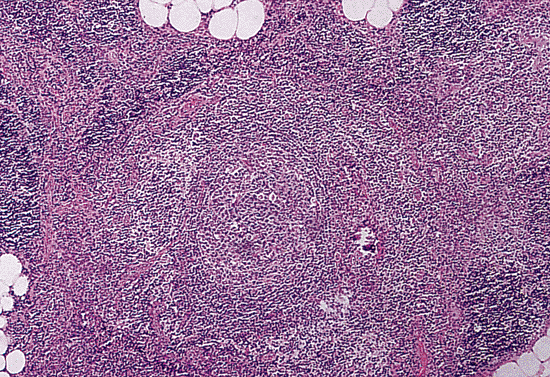 |
Figure 19.8 Lymphoid follicle with germinal center in normal thymus. |
Isolated B cells are found in both fetal and normal adult thymuses distributed along the septa, in close proximity to small vessels at the corticomedullary junction and in the medulla (57). Intrathymic B cells have been found to be significantly increased in patients with myasthenia gravis, a finding that some investigators consider to be a more specific change for this disorder than the presence of germinal centers (57,58). More recently, a population of intramedullary B cells with a tendency to cluster around Hassall's corpuscles has been identified in the thymus gland from fetuses, newborn babies, children, and adults; these lymphocytes show evidence of activation and bear a distinctive immunophenotype (59). Unlike B cells of germinal centers and surrounding mantle zones, the medullary B cells are negative for CD21 and do not express surface/cytoplasmic immunoglobulins. It has been proposed that a significant proportion of non-Hodgkin's lymphomas of the B-cell type located in the anterior mediastinum arise from this intrathymic B-cell population. Additionally, a newly described type of mucosa-associated lymphoid tissue (MALT) lymphoma composed of monocytoid B cells recently was identified as arising from the thymus (60); this finding raises the possibility that monocytoid B cells may be another as yet unidentified cellular constituent of the normal thymus (61).
Several other types of hematolymphoid cells are present in small number but constant fashion in the normal thymus (62,63,64). Macrophages are mainly located in the cortex, show phagocytic activity, are markedly -naphthyl acetate esterase positive, acid phosphatase positive, and HLA-DR negative, and are antigenically indistinguishable from macrophages of other organs (45,64). Interdigitating dendritic cells are mainly located in the medulla, are markedly HLA-DR positive, have little lysosomal enzyme activity, and show S-100 protein reactivity (65). Both of these cell types are thought to be involved in lymphocyte and epithelial cell interaction.
Langerhans cells also have been identified in the thymic medulla; both interdigitating dendritic cells and Langerhans cells are said to be increased in the thymuses of patients with myasthenia gravis (66). The latter cells provide the anatomic substrate for the development of Langerhans cell granulomatosis (histiocytosis X) within the thymus (67). Eosinophils are usually present in the thymus of children, sometimes in large numbers (68). They appear in fetal life and persist until puberty, after which they become infrequent. They are found mainly in the connective tissue septa or within the medulla and occasionally may be present within Hassall's corpuscles.
Mast cells are also normally present in human thymuses. They are usually found within and scattered parallel to the connective tissue septa, often in a perivascular location. The presence of mast cells can be a source of confusion in the course of immunohistochemical and other special stains of the thymus gland because of their propensity to react with a wide variety of reagents; they are easily identified by the use of metachromatic stains. Increased numbers of mast cells in the thymus have been observed in patients with severe combined immunodeficiency and thymic alymphoplasia (69), but the significance of this finding is not understood. Plasma cells are rare in the normal thymus; they are usually located in the connective tissue septa or, more rarely, in the medulla (70). Plasma cells may be numerous in the involuting thymus and also may be present in increased numbers in the thymus of patients with myasthenia gravis (71).
Neuroendocrine cells are now accepted as being a minor but constant component of the normal thymus (72). Peptide- and amine-producing neuroendocrine cells have been identified in the thymus glands of reptiles and birds (73,74,75) and, to a lesser degree, in mammalian (including human) thymuses. It has been postulated that some of these cells may be embryologically and functionally analogous to C cells of thyroid (76). The physiologic role of these various neuroendocrine elements in the thymus is not yet understood, but their presence has been offered as the probable substrate for the development of carcinoid tumors and other neuroendocrine neoplasms in this organ, including calcitonin-positive medullary carcinomas (77,78).
Myoid cells are located in the thymic medulla. They are common in reptilian and avian thymuses but also can be found (albeit with some difficulty) in human thymuses, particularly in infants. They have microscopic, immunohistochemical, and ultrastructural features of striated muscle cells (79,80). Their histogenesis remains a subject of debate, some studies pointing toward a derivation from the neural crest (81) and others showing the existence of shared epitopes with thymic epithelial cells (82). Myoid cells have been said to be increased in the thymus of patients with myasthenia gravis (57,83) and in patients with true thymic
P.512
hyperplasia (84), suggesting that these cells may play a role in immunoregulatory mechanisms. Thymic neoplasms thought to represent the neoplastic counterpart of myoid cells also have been described (85).
Germ cells are another cellular element thought to be normally present in the thymus. It has been proposed that scattered germ cells reach the thymus during ontogenesis and that some of them persist into adult life. However, direct evidence of their presence in the normal thymus gland has never been demonstrated, and the only presumptive evidence of their occurrence is the fact that nearly all mediastinal germ cell tumors arise within the thymus (9). Rosai et al. (86) have recently proposed that germ cells in the thymus may develop into somatic cells, thus making their detection and identification difficult by conventional means. They further hypothesized that thymic myoid cells may be of germ cell origin and thus provide indirect evidence for the existence of the latter in this organ (86).
Connective tissue elements of the thymus include vessels, fibrous tissue, nerves, and fat. The vasculature of the thymus arises from arteries that enter the organ via fibrous trabeculae from the capsule. In contrast to other major lymphoid organs, the thymus lacks a hilus. The thymic vessels are ensheathed by a layer of thymic epithelial cells. This anatomic configuration, plus the failure of the thymus to produce antibodies against circulating antigen, led to the concept of the blood-thymus barrier (87). Raviola and Karnovsky (88), in an elaborate study using electron-opaque tracers of different molecular dimensions, demonstrated convincingly that, although some bloodborne macromolecules do penetrate the thymus, their distribution was limited to the medulla, thus pointing to the existence of a blood-thymus barrier operating at the level of the cortex. However, more recent studies have challenged the concept of the blood-thymus barrier by showing that the thymic cortex also may be permeable to immunoglobulin molecules present in the extravascular compartment (89).
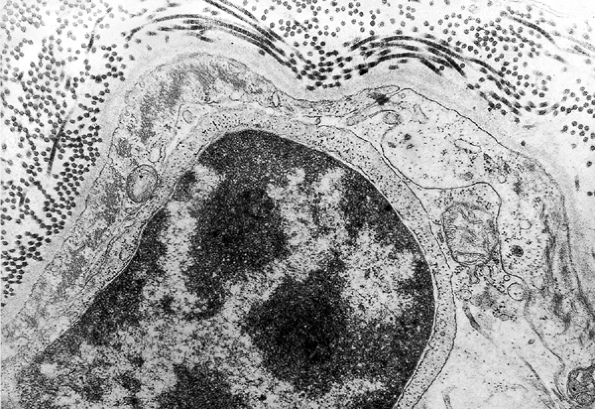 |
Figure 19.9 Ultrastructural detail of normal cortical epithelial cells showing large cytoplasmic processes joined by a desmosome and wrapped around a small lymphocyte. A thick basal lamina separates the epithelial cells from the surrounding collagen. (Reprinted with permission from: Rosai J, Levine GD. Tumors of the thymus. In: Atlas of Tumor Pathology. 2nd series, fascicle 13. Washington, DC: Armed Forces Institute of Pathology; 1976. ) |
The presence of a distinct anatomic compartment bound by the vessel wall and the sheath of epithelial cells has been postulated. It has further been suggested that it is through these perivascular spaces that the mature T-cells exit the thymus to colonize peripheral lymphoid organs once their maturation process is complete. The spaces are inconspicuous in the normal thymus; they may appear dilated in atrophic and involuting organs, but they acquire their greatest prominence in some thymomas (9).
Ultrastructure
Ultrastructurally, very elongated cytoplasmic processes can be appreciated in the epithelial cells of the thymic cortex, which are also covered by basal lamina material (Figure 19.9) (90,91,92). Medullary epithelial cells are more densely packed and have blunted cytoplasmic projections (Figure 19.10). A consistent feature of medullary epithelial cells is the greater frequency of desmosomes and the presence of dense tonofilaments that often insert into desmosomes. This feature is particularly obvious in Hassall's corpuscles. Cortical epithelial cells may display a range of ultrastructural appearances depending on the electron density of their cytoplasm, including pale cells with electron-lucent cytoplasm, intermediate cells with variable electron density, and dark cells with electron-dense cytoplasm. The same range may be observed in medullary epithelial cells; in addition, the medulla contains undifferentiated epithelial cells with sparse cytoplasm (93).
Thymic myoid cells display ultrastructural features of skeletal muscle, including myofilaments with dense
P.513
patches (Figure 19.11). Some investigators have identified cells displaying both tonofilaments and myofilaments by electron microscopy, and in some instances myoid cells have been observed to display desmosomal connections with epithelial cells (94).
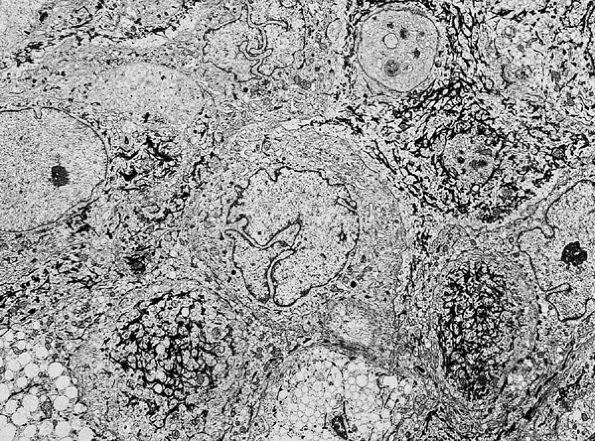 |
Figure 19.10 Ultrastructural detail of medullary epithelial cells showing compact arrangement and blunted cytoplasmic projections. (Reprinted with permission from: Rosai J, Levine GD. Tumors of the thymus. In: Atlas of Tumor Pathology. 2nd series, fascicle 13. Washington, DC: Armed Forces Institute of Pathology; 1976. ) |
Immunohistochemistry
Thymic Epithelial Cells
Immunohistochemical studies have demonstrated that thymic epithelial cells may express a variety of distinctive differentiation antigens. Currently, at least four antigenically distinctive types of epithelial cell are recognized in the normal thymus: subcapsular cortical, inner cortical, medullary, and the cells of Hassall's corpuscles (Table 19.1) (95,96,97,98). Inner cortical epithelium, in addition to exhibiting keratin positivity, strongly reacts with TE-3, a murine monoclonal antibody raised against human thymic stroma (99). Subcapsular cortical epithelial cells and medullary epithelial cells react strongly with TE-4 monoclonal antibody. Both of these cells also label with A2B5, a monoclonal antibody directed against a complex neuronal ganglioside found on the cell surface of neurons and neuroendocrine cells (100).
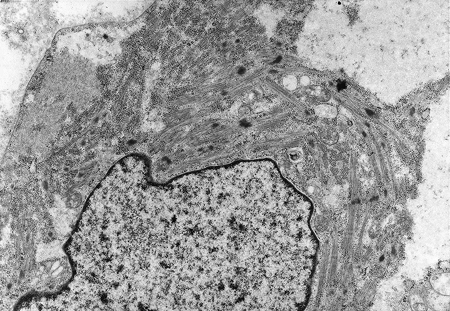 |
Figure 19.11 Ultrastructural appearance of myoid cell in the thymus. Note bundles of actin and myosin myofilaments with clearly discernible Z lines in the cytoplasm. |
Another marker of subcapsular cortical epithelium and medullary epithelium in normal thymus is that detected
P.514
with anti-p19, an antibody that defines the structural core protein of the human T-cell lymphoma virus and that is believed to be acquired during normal thymic ontogeny. In the normal human thymus, the antigen defined by anti-p19 is found to parallel the reactivity of A2B5 antibody in epithelial cells (101). Interestingly, a recent study on thymomas has demonstrated that the expression of the p19 antigen is lost with malignant transformation (102).
Table 19.1 Summary of Main Antigenic Determinants Found in Epithelial Cells of the Normal Thymus | |||||||||||||||||||||||||||||||||||||||||||||
|---|---|---|---|---|---|---|---|---|---|---|---|---|---|---|---|---|---|---|---|---|---|---|---|---|---|---|---|---|---|---|---|---|---|---|---|---|---|---|---|---|---|---|---|---|---|
|
Subcapsular cortical, inner cortical, and medullary epithelial cells also have been found to express class I and class II major histocompatibility antigens (97,103). However, recent studies using double immunolabeling have shown that HLA-DR expression is absent in medullary epithelial cells and that the positivity reported in previous studies may have been the result of diffusion of the stain from surrounding interdigitating dendritic cells (104). A recent study has demonstrated that the epithelial cells in the normal thymus and in thymomas also express epithelium-associated glycoprotein H (tissue blood group O antigen), peanut agglutinin receptor antigen (PNA-r), and Saphora Japonica agglutinin receptor antigen (SJA-r), which are detectable by lectin binding (105). Recent studies also have demonstrated expression of the epidermal growth factor receptor and transforming growth factor alpha in subcapsular, cortical, and medullary epithelial cells, suggesting that this substance plays a role in the growth and differentiation of these cells (106). Subcortical epithelial cells lining the boundaries between the thymic parenchyma and its surrounding fibrous tissue also demonstrate positivity for Leu-7, a differentiation antigen found in human null/killer cells and neuroendocrine cells (107). The cells of Hassall's corpuscles show the strongest keratin positivity of all thymic epithelial cells and react particularly strongly with the high-molecular weight keratin AE2 antibody, which is considered a marker of terminal epithelial maturation (108). Conversely, they are unreactive for the other antigens mentioned above.
Thymic Lymphocytes
The normal lymphoid population of the thymus has been shown to exhibit marked immunophenotypic heterogeneity, reflective of their functional status. The very term thymocyte, which was originally introduced to designate all thymic lymphocytes, has acquired a more specific immunologic meaning and is now restricted to immature thymic lymphocytes of T-cell lineage (with the exclusion of pre T-cell lymphocytes). Thymocytes can be divided into three types in accordance with their different stages of intrathymic maturation (19,109,110,111) (Table 19.2). The earliest stage of differentiation is found in subcapsular thymocytes, which are characterized by a Leu-1+ (T1), Leu-2a+ (T8), Leu-3a+ (T4), Leu-4+ (T3), Leu-5+ (T11), Leu-6+ (T6), Leu-9+ (T2), Tdt+, and T200+ phenotype (Figure 19.12A). The next stage in maturation is seen in cortical thymocytes, which comprise the majority of thymic lymphocytes (60 70%) and are characterized by a Leu-1+ (T1), Leu-2a+ (T8), Leu-3a+ (T4), Leu-4+ (T3), Leu-5+ (T11), Leu6+ (T6), Leu-9+ (T2), Leu-M3, OKT-10 (T10), Tdt+, and T200+ phenotype. The last stage of intrathymic maturation is seen in medullary thymocytes, which show a Leu-1+ (T1), Leu-4+ (T3), Leu-5+ (T11), Leu -9+ (T2), and T200+ phenotype (Figure 19.12B).
Antigens Leu-2a and Leu-3a are present in only one third to two thirds of these cells, respectively (57,109). Of the above markers, the ones that may distinguish specifically between cortical and medullary thymocytes are CD1, CD14, CD38, and Tdt. Recent studies on thymomas have attempted to correlate the degree of T-cell maturation with the morphologic appearance of the tumor (107,112,113,114). It has been well established that the lymphoid cell population in thymomas is made up of immature T cells (113,115,116). In lymphocyte-rich thymomas, the lymphocytes have the phenotypic markers of cortical thymocytes; it has, therefore, been proposed that these tumors are attempting to recapitulate the structure and function of the cortical compartment of the normal thymus (114,117,118). In the better-differentiated examples, the analogy with the normal thymus is accentuated by the presence of foci of medullary differentiation. These findings support the originally proposed theory that, in thymomas, prothymocytes from the stem cell compartment undergo a series of maturational events induced by the neoplastic thymic epithelial cells analogous to those that take place in the normal thymus, the lymphoid elements in these tumors thus being an environmental rather
P.515
P.516
than a neoplastic component (9). This contention, which was initially based solely on light microscopic observations of thymomas, has recently gained support from studies with DNA hybridization for T-cell receptor genes that showed that the lymphoid elements in thymomas lacked gene rearrangements that would denote a clonal proliferation of T-cells (119). As already indicated, such interaction is thought to be mediated by thymic hormones produced by thymic epithelial cells.
Table 19.2 Sequence of Maturation in Thymic Lymphocytes | ||||||||||
|---|---|---|---|---|---|---|---|---|---|---|
|
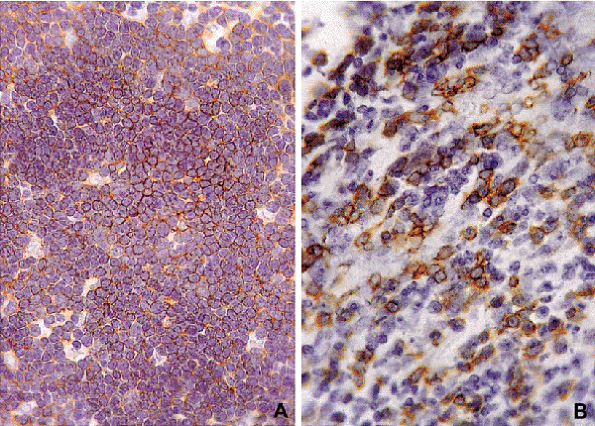 |
Figure 19.12 A. Immunoperoxidase stain of cortical thymocytes on fresh frozen tissue with Leu-1 (CD5) antibody. B. Medullary thymocytes showing focal Leu-3a (CD4) positivity on fresh frozen tissue. |
Molecular Biology
Molecular studies have demonstrated the presence of rearrangement and expression of T-cell antigen receptors (TCRs) in thymic lymphocytes. Expression of the TCR represents a critical step in the development of T cells in the thymus (120,121). The TCR molecules are heterodimeric proteins analogous in structure to the immunoglobulin molecules. Rearrangement and expression of the TCRs are needed for the T cell to recognize antigen in association with self major histocompatibility complex (MHC) antigens. There are two major types of TCRs: one type contains -and -polypeptide chains, and the other contains - and -chains. The - -TCR is expressed in nearly all T cells, whereas the - -TCR is expressed in only about 2% of T cells. Immature thymic lymphocytes (CD4-/CD8-) have been shown to contain mRNA only for the -chain of the TCR. Mature thymic lymphocytes (CD4/CD8+), on the other hand, contain mRNA for both - and -chains (122).
As immature thymocytes begin to undergo T-cell receptor gene rearrangements, they first acquire cytoplasmic then cell surface expression of CD3, CD4, and CD8. The CD4+/CD8+ (i.e., double positive ) lymphocytes are located within the thymic cortex and also express CD1a surface marker, as well as strong positivity for the Ki-67 nuclear proliferation antigen (43). As double-positive thymocytes complete their T-cell receptor gene rearrangement and undergo positive and negative selection, they progressively lose their expression of CD1a, Ki-67, and either CD4 or CD8. The resulting single positive thymocytes (either CD4+/CD8- or CD4-/CD8+) migrate into the thymic medulla, where they complete their maturation before they are released into the circulation.
The genetic mechanisms that promote lineage commitment in the thymus are not well understood. Recent studies have suggested that there are at least 25 genes involved in the segregation of the different T-cell lineages. Commitment to the CD4 lineage appears to be controlled by upregulation of genes associated with increased survival followed by expression of genes that regulate nucleosome remodeling and T-cell receptor signaling. Commitment to the CD8 lineage appears to be influenced by upregulation of genes that regulate lymphocyte homing followed by suppression of genes that inhibit apoptosis (123).
Function
The thymus plays a central role in cell-mediated immunity. In early embryonic development, prothymocytes enter the thymus from the bone marrow and migrate to the outer cortex, where they undergo a process of maturation. Mature thymocytes move from the outer cortex to the medulla then migrate into the peripheral circulation, where they function as mature T cells. During their sojourn in the thymus, T cells learn to distinguish self from nonself and acquire the ability to recognize antigens bound to cell surface molecules encoded by the major histocompatibility complex (MHC). Circulating helper (CD4+) and suppressor (CD8+) thymus-derived T cells play a variety of roles in cell-mediated immunity, including the induction of cytotoxicity, delayed-type hypersensitivity reactions, and transplant rejection.
A controversial aspect of thymic function is that related to the production of thymic hormones, which are thought to play a role in the induction of differentiation of early T-cell precursors in the thymus. Four distinct types of thymic hormones have been identified: thymopoietin, thymosin 1, thymulin (formerly known as facteur thymique serique), and thymic humoral factor (122,124,125). Thymopoietin and thymulin are said to be produced only by thymic epithelium, whereas thymosins are a family of peptides that are synthesized in many organs. The production of thymic hormones by thymic epithelial cells has been an extremely interesting but highly contested subject. At the immunohistochemical level, studies using polyclonal and monoclonal antibodies claim to have demonstrated the presence of thymulin, thymosin 1, and thymopoietin in the cytoplasm of murine and human thymic epithelial cells (125,126,127,128). In some studies, the hormone localization has been found to be restricted to A2B5+ cells, that is, subcapsular cortical and medullary epithelial cells (129). This finding has led to the suggestion that these two cell subtypes represent the functional (secretory or endocrine) portion of the thymus, as contrasted with the nonsecretory epithelium of the inner cortical region and of Hassall's corpuscles. In a murine system, thymic hormones also have been described in a subtype of medullary epithelial cell characterized ultrastructurally by numerous cytoplasmic membrane bound vacuoles containing amorphous material (130). A study by Hirokawa et al. (131), using rabbit antisera against synthetic thymosin 1 and bovine thymosin 3 in 45 cases of human thymomas and normal thymus of newborns, described reactivity of the tumor cells and normal thymic epithelial cells with these antibodies in 80 and 89% of cases, respectively. The thymosin-containing cells were said to be predominantly localized to the medulla and the subcapsular cortex, and the reaction was most intense in the lymphocyte-rich thymomas. These reactions appeared to be specific for thymic tumors because neither thymosin 1 nor thymosin 3 could be detected in other epithelial malignancies tested, including gastric, pulmonary, and hepatic carcinomas. So far, however, sufficiently
P.517
reliable specific antibodies have not become available for routine use in diagnostic pathology.
In addition to thymic hormones, thymic epithelial cells may contain a wide variety of neuropeptides such as oxytocin, vasopressin, -endorphin, somatostatin, and other anterior pituitary hormones (132,133,134), as well as produce various cytokines and growth factors, including interleukin (IL)-1, IL-6, and granulocyte-monocyte colony-stimulating factor (135,136).
The spectrum of biological effects of cytokines in the thymus is determined by the expression of cytokine receptors on the thymic cell surface. Thymic cytokines may act by autocrine or paracrine mechanisms. Examples of paracrine thymic cytokines are IL-7, which induces thymocyte growth and differentiation, and interferon (INF)- (produced by thymocytes), which induces thymic epithelial cell activation. An example of an autocrine factor is IL-2, for which the producers and targets are thymocytes. The ability of thymocytes to produce cytokines and express cytokine receptors is gradually reduced as they mature from the stage of precursor cells to cortical thymocytes. After the completion of the selection process of maturation, the ability of thymocytes to produce cytokines and respond to their action is restored (137). The role and function of cytokines in the thymus is different from that of cytokines in the peripheral compartments of the immune system; in the thymus they are involved with the migration and development of thymocytes and autoregulation of thymocytes cell numbers, while in the periphery they are mainly involved in the regulation of inducible processes such as inflammation, immune response, etc.
Age-Related and other Trophic Changes
Thymic Involution
The thymus undergoes a slow physiologic process of involution with age. This process starts at puberty, at which time the organ reaches its maximum absolute weight. From then on, it undergoes gradual and progressive atrophic changes (138,139,140). This process of aging, also known as physiologic involution, is accompanied by gradual changes in thymocyte populations relative to different rates of involution of the cortical and medullary epithelium. In its early stages, the changes consist primarily of a decrease in the number of cortical thymocytes with relative sparing of the epithelial elements (141). In the more advanced stages, the parenchyma of the thymus reverts to a more primitive appearance and is replaced by islands of epithelial cells depleted of lymphocytes, with partly cystic, closely aggregated Hassall's corpuscles and abundant intervening adipose tissue (142). It should be realized that, whereas thymic involution can proceed to a point where no thymic tissue can be appreciated grossly, microscopic thymic remnants are probably always present. The best way to locate them is to examine microscopically the preepicardial fat in a subserial fashion. Recent studies have suggested that the process of involution in the thymus may be quantitative rather than qualitative. It has been demonstrated that thymopoiesis continues to occur in the thymus of adult humans late into life and that thymic activity and function appear to be well maintained into old age and may be indispensable for T-cell reconstitution in different immunological settings (143,144,145).
A type of change not related to senescence that must be distinguished from the normal physiologic type of involution is accidental or stress involution. This condition results from the dramatic response of the thymus gland to episodes of severe stress, in which the sudden release of corticosteroids from the adrenal cortex leads to rapid depletion of thymic cortical lymphocytes (146). Microscopically, there is prominent karyorrhexis of lymphocytes with active phagocytosis by macrophages, which creates a prominent starry sky appearance characteristically confined to the cortex. If the stimulus persists, a loss of corticomedullary distinction ensues, with accentuation of the epithelial elements, cystic dilatation of Hassall's corpuscles, and the emergence of elongated, epithelium-lined cystic spaces that recapitulate the early stages of Hassall's corpuscle formation. With further loss of thymocytes, the lobular architecture collapses and fibrosis ensues. The thymus is thus transformed into a mass of adipose tissue containing scattered islands of parenchyma with a few lymphocytes.
Acute thymic involution in infancy and childhood has been observed to significantly correlate with the duration of acute illness. It has been proposed that morphologic parameters such as the presence of abundant macrophages in the cortex, increase of interlobular fibrous tissue, and lymphoid depletion of the cortex may enable the pathologist to estimate the duration of acute disease before death (147). A precocious type of thymic involution manifested by epithelial injury also has been observed in both children and adult patients with acquired immunodeficiency syndrome (AIDS) (148,149). These changes have been interpreted by some as an indication that the thymus may constitute a primary target organ in human immunodeficiency virus infection (150), whereas others have considered these changes as an expression of stress involution (149,151).
Thymic Hyperplasia
True thymic hyperplasia is defined as an enlargement of the thymus gland (as determined by weight or volume) beyond that considered as the upper limit of normal for that particular age group (152). The existence of true thymic hyperplasia has been questioned in the past, largely because of the diagnostic excesses committed with the much-abused concept of status thymicolymphaticus. The latter is probably a myth, but true thymic hyperplasia is currently accepted as a distinct entity (153,154,155).
P.518
To establish a diagnosis of true thymic hyperplasia, reference must be made to standard weight charts of normal thymus glands for comparison. Hammar, in 1906 (156), made the first extensive studies on the normal weights of the thymus in fresh autopsy specimens; these studies have remained for many years as the standard. More recently, several workers have updated these studies; the most comprehensive of these is that of Steinman (140), who examined the weight and volume of human thymuses in 136 healthy individuals (Table 19.3). He concluded that determination of the volume of the gland, as measured by the displacement of a physiologic saline solution, was more reliable than weighing the gland and constitutes the optimal parameter for this type of evaluation.
Thymic hyperplasia has been recognized as a complication of chemotherapy for Hodgkin's disease in children (157,158) and germ cell tumors in adults (159,160) and has been interpreted as the expression of an immunologic rebound phenomenon. A similar enlargement of the thymus also has been observed in children recovering from thermal burns (161) and after cessation of administration of corticosteroids in infants (162). Marked enlargement of the thymus has also been observed in the setting of thymic reconstitution after chemotherapy (163) or after the institution of antiretroviral therapy in HIV-infected patients (164).
True thymic hyperplasia must be distinguished from lymphoid hyperplasia. In the latter condition, the term hyperplasia refers to an increased number of lymphoid follicles in the medullary region of the gland. This is the result of increased migration of mature T and B cells into the perivascular space, adjacent to but outside of the thymic epithelial meshwork. The problem in establishing the presence of lymphoid hyperplasia vis- -vis the occurrence of lymphoid follicles in the normal thymus has already been discussed. Lymphoid hyperplasia of the thymus most commonly has been associated with myasthenia gravis but also has been observed in several other immune-mediated disorders, including systemic lupus erythematosus, rheumatoid arthritis, scleroderma, allergic vasculitis, and thyrotoxicosis.
Table 19.3 Weight and Volume of Normal Human Thymuses | ||||||||||||||||||||||||||||||||||||||||||||||||||||||||||||||||||||
|---|---|---|---|---|---|---|---|---|---|---|---|---|---|---|---|---|---|---|---|---|---|---|---|---|---|---|---|---|---|---|---|---|---|---|---|---|---|---|---|---|---|---|---|---|---|---|---|---|---|---|---|---|---|---|---|---|---|---|---|---|---|---|---|---|---|---|---|---|
| ||||||||||||||||||||||||||||||||||||||||||||||||||||||||||||||||||||
Artifacts and other Potential Pitfalls in Differential Diagnosis
Microscopic changes related to involution may be a source of considerable confusion in the interpretation of thymic biopsies. Such changes are primarily related to the distribution, architectural arrangement, and cytologic appearance of the epithelial cells (Figure 19.13). Some of these cells may acquire a spindle, mesenchyma-like appearance, whereas others can arrange themselves in rosettelike formations devoid of central lumina (Figure 19.14). The fact that both of these appearances also are found with some frequency in thymic dysplasia and thymoma (but not in the normal active gland of infancy) suggests that they represent regressive and functionally inactive states of the epithelial cells (9).
Sometimes thymic remnants are almost exclusively formed of epithelial elements, arranged in well-defined round nests that may simulate neuroendocrine growths (165) (Figure 19.15). A particularly distinctive appearance is that of thin, elongated strands of thymic epithelium composed of a single or double cell layer, surrounded by or circumscribing dense connective tissue in a fibroepitheliomatous fashion. These thin, elongated epithelial strands may often be flanked by small lymphocytes and may occasionally exhibit an antlerlike, branching configuration (Figure 19.16A). They may be seen by themselves or at the periphery of thymic cysts, thymomas, thymic lymphomas, and other thymic neoplasms. In the case of thymic lymphomas and seminomas, these strands can be present not only around but also within the tumor, surrounded and infiltrated by the neoplastic elements. Their presence, whether detected at the hematoxylin and eosin (H&E) level or with the more sensitive techniques of ultrastructure and immunohistochemistry, can be interpreted erroneously as evidence supporting an epithelial nature for the lesion (Figure 19.16B). As a matter of fact, in our experience these formations constitute the single most important cause of misdiagnosis in cases of large cell lymphoma of the thymus. Conversely, some thymic remnants (perhaps the majority) are made up almost exclusively of lymphocytes,
P.519
P.520
thus simulating lymph nodes. A clue to their real nature should be sought at the very periphery, in which epithelial cells can sometimes be identified encircling the nests, perhaps representing the residual coat of subcapsular cortical cells of the normal organ (Figure 19.17).
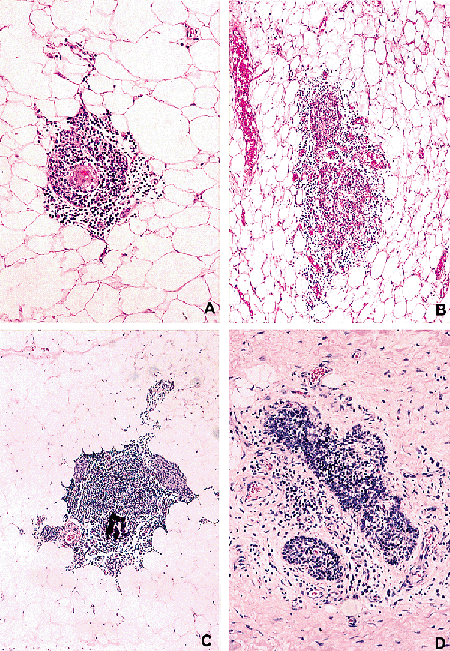 |
Figure 19.13 Epithelial remnants in involuting thymus. A. Abortive Hassall's corpuscle surrounded by small lymphocytes and scattered epithelial cells. B. Anastomosing strands of epithelial cells surrounded by small lymphocytes embedded within the preepicardial fat. C. Residual thymic island with predominance of lymphocytes, small solid epithelial cell clusters at the periphery, and calcified Hassall's corpuscle. D. Anastomosing strands of epithelial cells admixed with small lymphocytes embedded within a collagenized stroma. |
 |
Figure 19.14 A. Thymic remnant showing elongated configuration with prominent spindling of the cells. B. Involuting thymus with epithelial rosettes. |
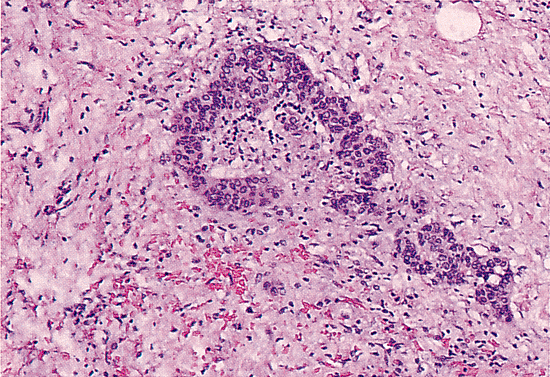 |
Figure 19.15 Strands of residual thymic epithelium arranged in small nests resembling neuroendocrine growths. |
 |
Figure 19.16 A. Wall of thymic cyst showing branching strands of thymic epithelial cells surrounded by a fibrous stroma. B. Entrapped thymic epithelial elements within anterior mediastinal malignant lymphoma. The strong keratin positivity seen in these cells may lead to an erroneous diagnosis of thymic carcinoma. |
Certain patterns of tissue response to injury in the thymus may also constitute a major source of confusion in the interpretation of biopsies of this organ (166). A common form of response of this organ to injury, particularly in cases associated with inflammation, is cystic degeneration of thymic epithelium. The cystic degeneration in such cases is thought to be the result of an acquired process, which in its fullest expression will lead to the formation of a multilocular thymic cyst (167). The main histologic features of such cysts include the formation of large cavities lined by squamous, columnar, or cuboidal epithelium, often in continuity with remnants of normal thymic epithelium within
P.521
the cyst walls; severe acute and chronic inflammation accompanied by fibrovascular proliferation, necrosis, hemorrhage, and cholesterol granuloma formation; and reactive lymphoid hyperplasia with the formation of prominent germinal centers. In some instances, the cyst lining may show a moderate degree of cytologic atypia with features of pseudoepitheliomatous hyperplasia that can be easily misinterpreted for malignancy (168). In the majority of cases the cystic structures are closely associated with Hassall's corpuscles, many of which show marked dilatation and may be found to be in continuity with the lining of the cystic cavities (Figure 19.18). We believe that this type of reaction is the result of an exaggerated response of medullary duct epithelium derived structures of the thymus to an underlying inflammatory process (167). However, it is important to point out that seemingly identical changes may take place in uninvolved thymic parenchyma in cases of Hodgkin's disease, mediastinal seminoma, and (less commonly) thymoma, to the extent that the neoplastic elements may be overshadowed by the cystic/inflammatory process (169,170). Other primary thymic neoplasms, which also may be closely associated with prominent cystic changes, although to a lesser extent, include basaloid carcinoma and mucoepidermoid carcinoma (171,172). Careful search and extensive sampling must therefore be undertaken in cystic mediastinal lesions for proper identification of the diagnostic neoplastic areas.
 |
Figure 19.17 A. Thymic remnant composed predominantly of small lymphocytes simulating a lymphoid nodule. Note the single row of flattened epithelial cells at the periphery. B. Thymic remnant composed of cortical and medullary portion, the latter containing a small Hassall's corpuscle (bottom half). |
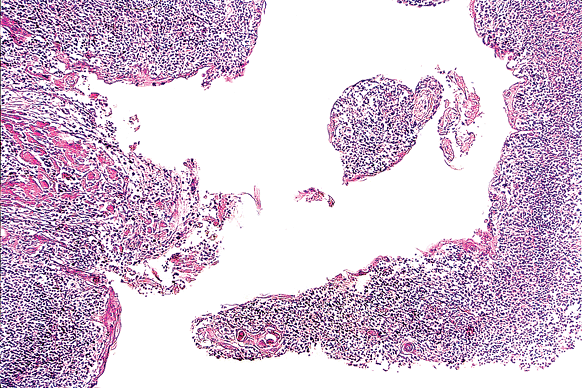 |
Figure 19.18 Cystic dilatation of Hassall's corpuscle. Notice dense inflammatory infiltrate within the wall of the cyst. |
Another form of tissue response to injury of the thymus that may introduce difficulties for diagnosis is that of stromal fibrosis. Fibrous overgrowth of the stroma may be the result of various mechanisms in a variety of nonneoplastic conditions [including a specific stimulus such as ionizing radiation or fungal infection (173,174)] or of undetermined etiology [such as in idiopathic sclerosing mediastinitis (175,176). In addition, a variety of malignant conditions of this organ also may be accompanied by prominent fibrous changes of the stroma, including primary diffuse large cell lymphoma of the mediastinum, Hodgkin's disease, and thymic seminoma (166). In many such instances, the gland may show extensive sclerosis with entrapment of a few scattered foci harboring the diagnostic atypical cells. Such cases may prove literally impossible to diagnose in small mediastinoscopic biopsies and will require extensive sampling of the mass to identify the diagnostic areas. The surgeon must be informed of the need for obtaining additional tissue for diagnosis at the time of frozen section examination.
Another potential pitfall for diagnosis is given by the high cellularity, immaturity, and mitotic activity of the normal thymic cortex, which can pose great diagnostic difficulties in mediastinoscopic biopsies and result in a mistaken diagnosis of malignant lymphoma, particularly of the
P.522
lymphoblastic type. The paucity or absence of cells with convoluted nuclei and the identification (morphologically or immunohistochemically) of epithelial cells regularly scattered throughout the lymphoid population should point toward the correct interpretation. Finally, an additional source of difficulty for diagnosis lies in the presence of biopsy-induced artifacts, one of the most common being the crush artifact, leading to marked nuclear elongation reminiscent of that seen in small cell carcinoma (Figure 19.19).
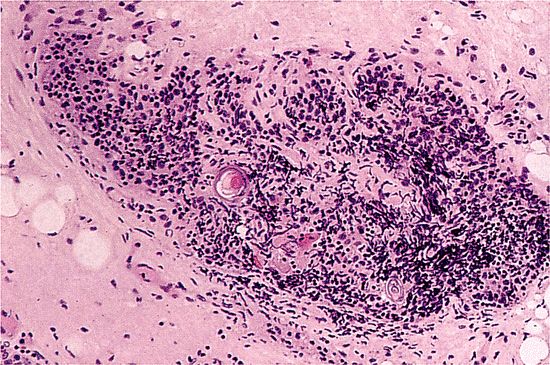 |
Figure 19.19 Extensive crush artifact is seen in this thymic remnant obtained through mediastinoscopic biopsy. |
References
1. Norris EH. The morphogenesis and histogenesis of the thymus gland in man: in which the origin of the Hassall's corpuscles of the human thymus is discovered. Contrib Embryol Carnegie Inst 1938;27:193 207.
2. Weller GL Jr. Development of the thyroid, parathyroid and thymus glands in man. Contrib Embryol Carnegie Inst 1933;24:93 139.
3. Cordier AC, Haumont SM. Development of thymus, parathyroids and ultimo-branchial bodies in NMRI and nude mice. Am J Anat 1980;157:227 263.
4. Gilmour JR. The embryology of parathyroid glands: the thymus and certain associated rudiments. J Pathol Bacteriol 1937;45:507 522.
5. Jotereau FV, Houssaint E, Le Douarin NM. Lymphoid stem cell homing to the early thymic primordium of the avian embryo. Eur J Immunol 1980;10:620 627.
6. Shier KJ. The thymus according to Schambacher: medullary ducts and reticular epithelium of the thymus and thymomas. Cancer 1981;48:1183 1199.
7. Gilmour JR. Some developmental abnormalities of the thymus and parathyroids. J Pathol Bacteriol 1941;52:213 218.
8. Nathaniels EK, Nathaniels AM, Wang CA. Mediastinal parathyroid tumors: a clinical and pathological study of 84 cases. Ann Surg 1970;171:165 170.
9. Rosai J, Levine GD. Tumors of the thymus. In: Atlas of Tumor Pathology. 2nd series, fascicle 13. Washington, DC: Armed Forces Institute of Pathology; 1976.
10. Domaniewski J, Ukleja Z, Rejmanowski T. Problemy immunologiczne I kliniczne w grasiczakach ektopicznych. Otolaringol Pol 1975;29:579 585.
11. Martin JME, Rundhawa G, Temple WJ. Cervical thymoma. Arch Pathol Lab Med 1986;110:345 357.
12. Yamashita H, Murakami N, Noguchi S, et al. Cervical thymoma and incidence of cervical thymus. Acta Pathol Jpn 1983;33:189 194.
13. Wadon A. Thymoma intratracheale. Zentralbl Allg Pathol Anat 1934;60:308 312.
14. Harach RR, Day ES, Fransilla KG. Thyroid spindle-cell tumor with mucous cysts. An intrathyroid thymoma? Am J Surg Pathol 1985;9:525 530.
15. Miyauchi A, Kuma K, Matsuzuka F, Matsubayashi A, Tamai H, Katayama S. Intrathyroid epithelial thymoma: an entity distinct from squamous cell carcinoma of the thyroid. World J Surg 1985;9:128 135.
16. Rosai J, Limas C, Husband EM. Ectopic hamartomatous thymoma: a distinctive benign lesion of the lower neck. Am J Surg Pathol 1984;8:501 513.
17. Gagens EW. Malformation of the auditory apparatus in the newborn associated with ectopic thymus. Arch Otolaryngol 1932;15:671 680.
18. Castleman B. Tumors of the thymus gland. In: Atlas of Tumor Pathology. 1st series, fascicle 19. Washington, DC: Armed Forces Institute of Pathology; 1955.
19. Wolff M, Rosai J, Wright DH. Sebaceous glands within the thymus. Report of 3 cases. Hum Pathol 1984;15:341 343.
20. Breckler IA, Johnston DG. Choristoma of the thymus. AMA J Dis Child 1956;92:175 178.
21. Landing B, Yutuc I, Swanson V. Clinicopathologic correlation in immunologic deficiency diseases of children, with emphasis on thymic histologic patterns. In: Proceedings of the International Symposium on Immunodeficiency. Tokyo: Tokyo University Press; 1976:3 33.
22. Blackburn WR, Gordon DS. The thymic remnant in thymic alymphoplasia. Light and electron microscopic studies. Arch Pathol 1967;84:363 375.
23. Hoyer JR, Cooper MD, Gabrielsen AE, Good RA. Lymphopenic forms of congenital immunologic deficiency diseases. Medicine (Baltimore) 1968;47:201 226.
24. Peterson RD, Kelly WD, Good RA. Ataxia-telangiectasia. Its association with a defective thymus, immunological-deficiency disease, and malignancy. Lancet 1964;1:1189 1193.
25. Cooper MD, Petersen RD, Good RA. A new concept of the cellular basis of immunity. J Pediatr 1965;67:907 908.
26. Nezelof C, Jammet M-L, Lortholary P, Labrune B, Lamy M. L'hypoplasie hereditaire du thymus: sa place et sa responsabilite dans une observation d'aplasie lymphocytaire, normoplasmocytaire et normoglobulinemique du nourrisson. Arch Fr Pediatr 1964;21:897 920.
27. Seemayer TA, Bolande RP. Thymus involution mimicking thymic dysplasia: a consequence of transfusion-induced graft versus host disease in a premature infant. Arch Pathol Lab Med 1980;104:141 144.
28. Huber J, Cholnoky P, Zoethout HE. Congenital aplasia of parathyroid glands and thymus. Arch Dis Child 1967;42:190 192.
29. Fowlkes BJ, Pardoll DM. Molecular and cellular events of T cell development. Adv Immunol 1989;44:207 264.
30. MacDonald HR, Lees RK. Programmed death of autoreactive thymocytes. Nature 1990;343:642 644.
31. Kizaki H, Tadakuma T. Thymocyte apoptosis. Microbiol Immunol 1993;37:917 925.
32. Colbert RA, Young DA. Glucocorticoid-induced messenger ribonucleic acids in rat thymic lymphocytes: rapid primary effects specific for glucocorticoids. Endocrinology 1986;119:2598 2605.
33. Domashenko AD, Nazarova LF, Umansky SR. Comparison of the spectra of proteins synthesized in mouse thymocytes after irradiation or hydrocortisone treatment. Int J Radiat Biol 1990;57:315 329.
34. Korsmeyer SJ. Bcl-2: a repressor of lymphocyte death. Immunol Today 1992;13:285 288.
35. Lowe SW, Schmitt EM, Smith SW, Osborne BA, Jacks T. p53 is required for radiation-induced apoptosis in mouse thymocytes. Nature 1993;362:847 849.
36. Smith CA, Williams GT, Kinsgton R, Jenkins EJ, Owen JJ. Antibodies to CD3/T-cell receptor complex induce death by apoptosis in immature T cells in thymic cultures. Nature 1989;337:181 184.
P.523
37. von Boehmer H. Positive selection of lymphocytes. Cell 1994;76:219 228.
38. Shi Y, Bissonnette RP, Parfrey N, Szalay M, Kubo RT, Green DR. In vivo administration of monoclonal antibodies to the CD3 T cell receptor complex induces cell death (apoptosis) in immature thymocytes. J Immunol 1991;146:3340 3346.
39. Blackman M, Kappler J, Marrack P. The role of the T cell receptor in positive and negative selection of developing T cells. Science 1990;248:1335 1341.
40. Mountz JD, Zhou T, Wu J, Wang W, Su X, Cheng J. Regulation of apoptosis in immune cells. J Clin Immunol 1995;15:1 16.
41. Hammar JA. Die Menschenthymus in Gesundheit und krankheit. Z Mikrosk Anat Forsch 1926;6(suppl):107 208.
42. Flores KG, Li J, Sempowski GD, Haynes BF, Hale LP. Analysis of the human thymic perivascular space during aging. J Clin Invest 1999;104:1031 1039.
43. Hale LP. Histologic and molecular assessment of human thymus. Ann Diagn Pathol 2004;8:50 60.
44. Suster S, Moran CA. Thymoma, atypical thymoma, and thymic carcinoma. A novel conceptual approach to the classification of thymic epithelial neoplasms. Am J Clin Pathol 1999;111:826 833.
45. Lobach DF, Haynes BF. Ontogeny of the human thymus during fetal development. J Clin Immunol 1987;7:81 97.
46. Dipasquale B, Tridente G. Immunohistochemical characterization of nurse cells in normal human thymus. Histochemistry 1991;96:499 503.
47. von Gaudecker B. Functional histology of the human thymus. Anat Embryol (Berl) 1991;183:1 15.
48. Rippert H. Die Entwicklungsst rung der Thymusdr se bei kongenitaler Lues. Frankfurt Z Pathol 1912;11:209 218.
49. Suster S, Rosai J. Multilocular thymic cyst: an acquired reactive process. Study of 18 cases. Am J Surg Pathol 1991;15:388 398.
50. Henry K. Mucin secretion and striated muscle in the human thymus. Lancet 1966;1:183 185.
51. Cantor H, Weissman I. Development and function of subpopulations of thymocytes and T lymphocytes. Prog Allergy 1976;20:1 64.
52. Everett NB, Tyler RW. Lymphopoiesis in the thymus and other tissues: functional implications. Int Rev Cytol 1967;22:205 237.
53. Middleton G. The incidence of follicular structures in the human thymus at autopsy. Aust J Exp Biol Med Sci 1967;45:189 199.
54. Vetters JM, Barclay RS. The incidence of germinal centres in thymus glands of patients with congenital heart disease. J Clin Pathol 1973;26:583 591.
55. Levine GD, Rosai J. Light and electron microscopy of the human fetal thymus. In: Johannessen JV, ed. Electron Microscopy in Human Medicine. Vol 5. New York: McGraw-Hill; 1980.
56. Goldstein G, Mackay IR. The thymus in systemic lupus erythematosus: a quantitative histopathological analysis and comparison with stress involution. Br Med J 1967;2:475 478.
57. Palestro G, Tridente G, Botto Micca F, Novero D, Valente G, Godia L. Immunohistochemical and enzyme histochemical contributions to the problem concerning the role of the thymus in the pathogenesis of myasthenia gravis. Virchows Arch B Cell Pathol Incl Mol Pathol 1983;44:173 186.
58. Shirai T, Miyata M, Nakase A, Itoh T. Lymphocyte subpopulation in neoplastic and non-neoplastic thymus and in blood of patients with myasthenia gravis. Clin Exp Immunol 1976;26:118 123.
59. Isaacson PG, Norton AJ, Addis BJ. The human thymus contains a novel population of B lymphocytes. Lancet 1987;2:1488 1491.
60. Isaacson PG, Chan JK, Tang C, Addis BJ. Low-grade B-cell lymphoma of mucosa-associated lymphoid tissue arising in the thymus: a thymic lymphoma mimicking myoepithelial sialadenitis. Am J Surg Pathol 1990;14:342 351.
61. Cardoso De Almeida P, Harris NH, Bhan AK. Characterization of immature sinus histiocytes (monocytoid cells) in reactive lymph nodes by use of monoclonal antibodies. Hum Pathol 1984;15:330 335.
62. Duijvestijn AM, Schutte R, Kohler YG, Korn C, Hoefsmit EC. Characterization of the population of phagocytic cells in thymic cell suspensions. A morphological and cytochemical study. Cell Tissue Res 1983;231:313 323.
63. Kaiserling E, Stein H, Muller-Hermelink HK. Interdigitating reticulum cells in the human thymus. Cell Tissue Res 1974;155:47 55.
64. Ruco LP, Rosati S, Monardo F, Pescarmona E, Rendina EA, Baroni CD. Macrophages and interdigitating reticulum cells in normal thymus and in thymoma: an immunohistochemical study. Histopathology 1989;14:37 45.
65. Lauriola L, Michetti F, Stolfi VM, Tallini G, Cocchia D. Detection by S-100 immunolabelling of interdigitating reticulum cells in human thymomas. Virchows Arch B Cell Pathol Incl Mol Pathol 1984;45:187 195.
66. Bofill M, Janossy G, Willcox N, Chilosi M, Trejdosiewicz LK, Newsom-Davis J. Microenvironments in the normal thymus and the thymus in myasthenia gravis. Am J Pathol 1985;119:462 473.
67. Siegal GP, Dehner LP, Rosai J. Histiocytosis X (Langerhans' cell granulomatosis) of the thymus: a clinicopathologic study of four childhood cases. Am J Surg Pathol 1985;9:117 124.
68. Bhathal PS, Campbell PE. Eosinophil leucocytes in the child's thymus. Australas Ann Med 1965;14:210 213.
69. Wise WS, Still WJ, Joshi VV. Severe combined immunodeficiency with thymic mast cell hyperplasia. Arch Pathol Lab Med 1976;100:283 286.
70. Goldstein G. Plasma cells in the human thymus. Aust J Exp Biol Med Sci 1966;44:695 699.
71. Henry K. The human thymus in disease with particular emphasis on thymitis and thymoma. In: Kendall MD, ed. The Thymus Gland. London: Academic Press; 1981:85 111.
72. Moll UM, Lane BL, Robert F, Greenen V, Legros JJ. The neuroendocrine thymus. Abundant occurrence of oxytocin-, vasopressin, and neurophysin-like peptides in epithelial cells. Histochemistry 1988;89:385 390.
73. Ciaccio C. Contributo all'istochimica delle cellule cromaffini. II. Cellule cromaffini del timo di gallum domesticus. Bull Soc Ital Biol Sper 1942;17:619 620.
74. Hakanson R, Larsson LI, Sundler F. Peptide and amine producing endocrine-like cells in the chicken thymus. A chemical, histochemical and electron microscopic study. Histochemistry 1974;39:25 34.
75. Vialli M, Casati C. Sulla presenza di cellule enterocromaffini nel timo dei rettili. Riv Istochim Norm Patol 1958;4:343.
76. Vialli M. Elementi del sistema delle cellule enterocromaffinie cellule C nel timo. Ann Histochem 1973;18:3 7.
77. Rosai J, Higa E. Mediastinal endocrine neoplasm, of probable thymic origin, related to carcinoid tumor: clinicopathologic study of 8 cases. Cancer 1972;29:1061 1074.
78. Wick MR, Rosai J. Neuroendocrine neoplasms of the thymus. Pathol Res Pract 1988;183:188 199.
79. Drenckhahn D, von Gaudecker B, Muller-Hermelink HK, Unsicker K, Groschel-Stewart U. Myosin and actin containing cells in the human postnatal thymus: ultrastructural and immunohistochemical findings in normal thymus and in myasthenia gravis. Virchows Arch B Cell Pathol Incl Mol Pathol 1979;32:33 45.
80. Hayward AR. Myoid cells in the human fetal thymus. J Pathol 1972;106:45 48.
81. Nakamura H, Ayer-Le Lievre C. Neural crest and thymic myoid cells. Curr Top Dev Biol 1986;20:111 115.
82. Dardenne M, Savino W, Bach JF. Thymomatous epithelial cells and skeletal muscle share a common epitope defined by a monoclonal antibody. Am J Pathol 1987;126:194 198.
83. Van de Velde RL, Friedman NB. Thymic myoid cells and myasthenia gravis. Am J Pathol 1970;59:347 368.
84. Judd RL, Welch SL. Myoid cell differentiation in true thymic hyperplasia and lymphoid hyperplasia. Arch Pathol Lab Med 1988;112:1140 1144.
85. Murakami S, Shamoto M, Miura K, Takeuchi J. A thymic tumor with massive proliferation of myoid cells. Acta Pathol Jpn 1984;34:1375 1383.
86. Rosai J, Parkash V, Reuter VE. On the origin of mediastinal germ cell tumors in men. Int J Surg Pathol 1995;2:73 78.
87. Marshall AHE, White RG. The immunological reactivity of the thymus. Br J Exp Pathol 1961;42:379 385.
88. Raviola E, Karnovsky MJ. Evidence for a blood thymus barrier using electron-opaque tracers. J Exp Med 1972;136:466 498.
P.524
89. Stet RJ, Wagenaar-Hilbers JP, Nieuwenhuis P. Thymus localization of monoclonal antibodies circumventing the blood-thymus barrier. Scand J Immunol 1987;25:441 446.
90. Bearman RM, Levine GD, Bensch KG. The ultrastructure of the normal human thymus. A study of 36 cases. Anat Rec 1978;190:755 781.
91. Hirokawa K. Electron microscopic observation of the human thymus of the fetus and the newborn. Acta Pathol Jpn 1969;19:1 13.
92. Pinkel D. Ultrastructure of the human fetal thymus. Am J Dis Child 1968;115:222 238.
93. van de Wijngaert FP, Kendall MD, Schuurman HJ, Rademakers LH, Kater L. Heterogeneity of epithelial cells in human thymus. An ultrastructural study. Cell Tissue Res 1984;237:227 237.
94. Henry K. The human thymus in disease with particular emphasis on thymitis and thymoma. In: Kendall MD, ed. The Thymus Gland. London: Academic Press; 1981:85 111.
95. de Maagd RA, MacKenzie WA, Schuurman HJ, et al. The human thymus microenvironment: heterogeneity detected by monoclonal anti-epithelial cell antibodies. Immunology 1985;54:745 754.
96. Haynes BF. The human thymic microenvironment. Adv Immunol 1984;36:87 142.
97. Janossy G, Thomas JA, Bollum FJ, et al. The human thymic microenvironment. An immunohistologic study. J Immunol 1980;125:202 212.
98. Van Ewijk W. Immunohistology of lymphoid and non-lymphoid cells in the thymus in relation to T lymphocyte differentiation. Am J Anat 1984;170:330 331.
99. McFarland EJ, Scearce RM, Haynes BF. The human thymic microenvironment: cortical thymic epithelium is an antigenically distinct region of the thymic microenvironment. J Immunol 1984;133:1241 1249.
100. Eisenbarth GS, Shimizu K, Bowring MA, Wells S. Expression of receptors for tetanus toxin and monoclonal antibody A2B5 by pancreatic islet cells. Proc Natl Acad Sci U S A 1982;79:5066 5070.
101. Haynes BF, Robert-Guroff M, Metzgar RS, et al. Monoclonal antibodies against human T cell leukemia virus p19 defines a human thymic epithelial antigen acquired during ontogeny. J Exp Med 1983;157:907 920.
102. Savino W, Berrih S, Dardenne M. Thymic epithelial antigen, acquired during ontogeny and defined by the anti-p19 monoclonal antibody, is lost in thymomas. Lab Invest 1984;51:292 296.
103. Bhan AK, Reinherz EL, Poppema S, McCluskey RT, Schlossman JF. Location of T cell and major histocompatibility complex antigens in the human thymus. J Exp Med 1980;152:771 782.
104. Bofill M, Janossy G, Willcox N, Chilosi M, Trejdosiewicz LK, Newsom-Davis J. Microenvironments in the normal thymus and the thymus in myasthenia gravis. Am J Pathol 1985;119:462 473.
105. Wiley EL, Nosal JM, Freeman RG. Immunohistochemical demonstration of H antigen, peanut agglutinin receptor, and Saphora japonica receptor expression in infant thymuses and thymic neoplasias. Am J Clin Pathol 1990;93:44 48.
106. Le PT, Lazorick S, Whichard LP, Haynes BF, Singer KH. Regulation of cytokine production in the human thymus: epidermal growth factor and transforming growth factor alpha regulate mRNA levels of interleukin 1 alpha (IL-1 alpha), IL-1 beta, and IL-6 in human thymic epithelial cells at a post-transcriptional level. J Exp Med 1991;174:1147 1157.
107. Chan WC, Zaatari GS, Tabei S, Bibb M, Byrnes RK. Thymoma: an immunohistochemical study. Am J Clin Pathol 1984;82:160 166.
108. Lobach DF, Scearce RM, Haynes BF. The human thymic microenvironment. Phenotypic characterization of Hassall's bodies with the use of monoclonal antibodies. J Immunol 1985;134:250 257.
109. Hsu SM, Jaffe ES. Phenotypic expression of T lymphocytes in thymus and peripheral lymphoid tissues. Am J Pathol 1985;121:69 78.
110. Janossy G, Bofill M, Trejdosiewicz LK, Willcox HN, Chilosi M. Cellular differentiation of lymphoid subpopulations and their microenvironments in the human thymus. In: Muller-Hermelink HK, ed. The Human Thymus: Histophysiology and Pathology. Berlin: Springer-Verlag; 1986:89 125.
111. Tidman N, Janossy C, Bodger M, Granger S, Kung PC, Goldstein G. Delineation of human thymocyte differentiation pathways utilizing double-staining techniques with monoclonal antibodies. Clin Exp Immunol 1981;45:457 467.
112. Chilosi M, Iannucci AM, Pizzolo G, Menestrina F, Fiore-Donati L, Janossy G. Immunohistochemical analysis of thymoma. Evidence of medullary origin of epithelial cells. Am J Surg Pathol 1984;8:309 318.
113. Mokhtar N, Hsu SM, Lad RP, Haynes BF, Jaffe ES. Thymoma: lymphoid and epithelial components mirror the phenotype of normal thymus. Hum Pathol 1984;15:378 384.
114. Sato Y, Watanabe S, Mukai K, et al. An immunohistochemical study of thymic epithelial tumors. II. Lymphoid component. Am J Surg Pathol 1986;10:862 870.
115. Lauriola L, Maggiano N, Marino M, Carbone A, Piantelli M, Musiani P. Human thymoma: immunologic characteristics of the lymphocytic component. Cancer 1981;48:1992 1995.
116. van der Kwast TH, van Vliet E, Cristen E, van Ewijk W, van der Heul RO. An immunohistologic study of the epithelial and lymphoid components of six thymomas. Hum Pathol 1985;16:1001 1008.
117. Eimoto T, Teshima K, Shirakusa T, et al. Heterogeneity of epithelial cells and reactive components in thymomas: an ultrastructural and immunohistochemical study. Ultrastruct Pathol 1986;10:157 173.
118. Shirai T, Miyata M, Nakase A, Itoh T. Lymphocyte subpopulation in neoplastic and non-neoplastic thymus and in blood of patients with myasthenia gravis. Clin Exp Immunol 1976;26:118 123.
119. Katzin WE, Fishleder AJ, Linden MD, Tubbs RR. Immunoglobulin and T-cell receptor genes in thymomas: genotypic evidence supporting the nonneoplastic nature of the lymphocytic component. Hum Pathol 1988;19:323 328.
120. Swerdlow SH, Angermeier PA, Hartman AL. Intrathymic ontogeny of the T cell receptor associated CD3 (T3) antigen. Lab Invest 1988;58:421 427.
121. Nikolic-Zugic J. Phenotypic and functional stages in the intrathymic development of alpha beta T cells. Immunol Today 1991;12:65 70.
122. Bach JF, Dardenne M, Pleau JM, Rosa J. Biochemical characteristics of a serum thymic factor. Nature 1976;266:55 56.
123. McCarty N, Shinohara ML, Lu L, Cantor H. Detailed analysis of gene expression during development of T cell lineages in the thymus. Proc Natl Acad Sci U S A 2004;101:9339 9344.
124. Goldstein AL, Low TLK, McAdoo M, et al. Thymosin alpha 1. Isolation and sequential analysis of an immunologically active thymic polypeptide. Proc Natl Acad Sci U S A 1977;74:725 729.
125. Goldstein G. The isolation of thymopoietin (thymin). Ann NY Acad Sci 1975;249:177 185.
126. Fabien N, Auger C, Monier JC. Immunolocalization of thymosin alpha 1, thymopoietin and thymulin in mouse thymic epithelial cells at different stages of culture: a light and electron microscopic study. Immunology 1988;63:721 727.
127. Jambon B, Montague P, Bene MC, Brayer MP, Faure G, Duheille J. Immunohistologic localization of facteur thymique serique (FTS) in human thymic epithelium. J Immunol 1981;127:2055 2059.
128. Savino W, Dardenne M. Thymic hormone-containing cells. VI. Immunohistologic evidence for the simultaneous presence of thymulin, thymopoietin and thymosin alpha 1 in normal and pathological human thymuses. Eur J Immunol 1984;14:987 991.
129. Haynes BF, Warren RW, Buckley RH, et al. Demonstration of abnormalities in expression of thymic epithelial surface antigens in severe cellular immunodeficiency diseases. J Immunol 1983;130:1182 1188.
130. Clark SL Jr. The thymus in mice of strain 129/J, studied with the electron microscope. Am J Anat 1963;112:1 33.
131. Hirokawa K, Utsuyama M, Moriizumi E, Hashimoto T, Masaoka A, Goldstein AL. Immunohistochemical studies in human thymomas. Localization of thymosin and various cell markers. Virchows Arch B Cell Pathol Incl Mol Pathol 1988;55:371 380.
132. Geenen V, Robert F, Defresne MP, Boniver J, Legros JJ, Franchimont P. Neuroendocrinology of the thymus. Horm Res 1989;31:81 84.
133. Jevremovic M, Terzic M, Kartaljevic G, Popovic V, Rosic B, Filipovic S. The determination of immunoreactive beta-endorphin concentration in the human fetal and neonatal thymus. Horm Metab Res 1991;23:623 624.
P.525
134. Batanero E, de Leeuw FE, Jansen GH, van Wichen DF, Huber J, Schuurman HJ. The neural and neuroendocrine components of the human thymus. II. Hormone immunoreactivity. Brain Behav Immun 1992;6:249 264.
135. Le PT, Lazorick S, Whichard LP, et al. Human thymic epithelial cells produce IL-6, granulocyte-monocyte-CSF, and leukemia inhibitory factor. J Immunol 1990;145:3310 3315.
136. Wainberg MA, Numazaki K, Destephano L, Wong I, Goldman H. Infection of human thymic epithelial cells by human cytomegalovirus and other viruses: effect on secretion of interleukin 1 like activity. Clin Exp Immunol 1988;72:415 421.
137. Yarilin AA, Belyakov IM. Cytokines in the thymus: production and biological effects. Curr Med Chem 2004;11:447 464.
138. Hirokawa K. Age-related changes of thymus. Morphological and functional aspects. Acta Pathol Jpn 1978;28:843 857.
139. Simpson JG, Gray ES, Beck JS. Age involution in the normal adult thymus. Clin Exp Immunol 1975;19:261 265.
140. Steinman GG. Changes in the human thymus during aging. In: Muller-Hermelink HK, ed. The Human Thymus. Histophysiology and Pathology. Berlin: Springer-Verlag; 1986:43 88.
141. Steinmann GG, Klaus B, Muller-Hermelink HK. The involution of the aging human thymic epithelium is independent of puberty. A morphometric study. Scand J Immunol 1985;22:563 575.
142. Smith SM, Ossa-Gomez LJ. A quantitative histologic comparison of the thymus in 100 healthy and diseased adults. Am J Clin Pathol 1981;76:657 665.
143. Jamieson BD, Douek DC, Killian S, et al. Generation of functional thymocytes in the human adult. Immunity 1999;10:569 575.
144. Bertho JM, Demarquay C, Moulian N, Van Der Meeren A, Berrih-Aknin S, Gourmelon P. Phenotypic and immunohistological analyses of the human adult thymus: evidence for an active thymus during adult life. Cell Immunol 1997;179:30 40.
145. Shanker A. Is thymus redundant after adulthood? Immunol Lett 2004;15:79 86.
146. Selye H. Thymus and adrenals in the response of the organism to injuries and intoxications. Br J Exp Pathol 1936;17:234 248.
147. van Baarlen J, Schuurman HJ, Huber J. Acute thymus involution in infancy and childhood: a reliable marker for duration of acute illness. Hum Pathol 1988;19:1155 1160.
148. Joshi VV, Oleske JM, Saad S, et al. Thymus biopsy in children with acquired immunodeficiency syndrome. Arch Pathol Lab Med 1986;110:837 842.
149. Seemayer TA, Laroche AC, Russo P, et al. Precocious thymic involution manifest by epithelial injury in the acquired immune deficiency syndrome. Hum Pathol 1984;15:469 474.
150. Grody WW, Fligiel S, Naeim F. Thymus involution in the acquired immunodeficiency syndrome. Am J Clin Pathol 1985;84:85 95.
151. Schuurman HJ, Krone WJA, Broekhuizen R, et al. The thymus in acquired immune deficiency syndrome. Comparison with other types of immunodeficiency diseases, and presence of components of human immunodeficiency virus type 1. Am J Pathol 1989;134:1329 1338.
152. Kendall MD, Johnson HR, Singh J. The weight of the human thymus gland at necropsy. J Anat 1980;131(pt 3):485 497.
153. Lack EE. Thymic hyperplasia with massive enlargement. Report of two cases with review of diagnostic criteria. J Thorac Cardiovasc Surg 1981;81:741 746.
154. Katz SM, Chatten J, Bishop HD, Rosenblum H. Massive thymic enlargement. Report of a case of gross thymic hyperplasia in a child. Am J Clin Pathol 1977;68:786 790.
155. Judd RL. Massive thymic hyperplasia with myoid cell differentiation. Hum Pathol 1987;18:1180 1183.
156. Hammar JA. Uber Gewicht Involution und Persistenz der Thymus im Postfotalleben der Menschen. Arch Anat Physiol Anat Abt 1906;(suppl):91 182.
157. Durkin W, Durant J. Benign mass lesions after therapy for Hodgkin's disease. Arch Intern Med 1979;139:333 336.
158. Shin M, Ho K. Diffuse thymic hyperplasia following chemotherapy for nodular sclerosing Hodgkin's disease. Cancer 1983;51:30 33.
159. Carmosino L, DiBenedetto A, Feffer S. Thymic hyperplasia following successful chemotherapy. A report of two cases and review of the literature. Cancer 1985;56:1526 1528.
160. Due W, Dieckmann KP, Stein H. Thymic hyperplasia following chemotherapy of a testicular germ cell tumor. Immunohistological evidence for a simple rebound phenomenon. Cancer 1989;63:446 449.
161. Gelfand DW, Goldman AS, Law AJ. Thymic hyperplasia in children recovering from thermal burns. J Trauma 1972;12:813 817.
162. Caffey J, Silbey R. Regrowth and overgrowth of the thymus after atrophy induced by the oral administration of adrenocorticosteroids to human infants. Pediatrics 1960;26:762 770.
163. Mackall CL, Fleisher TA, Brown MR, et al. Age, thymopoiesis, and CD4+ T-lymphocyte regeneration after intensive chemotherapy. N Engl J Med 1995;332:143 149.
164. Markert ML, Alvarez-McLeod AP, Sempowski GD, et al. Thymopoiesis in HIV-infected adults after highly active antiretroviral therapy. AIDS Res Hum Retroviruses 2001;17:1635 1643.
165. Croxatto OC. Cordones epiteliales con aspecto endocrino observado en restos timicos del adulto. Medicina (B Aires) 1972;32:203 208.
166. Suster S, Moran CA. Malignant thymic neoplasms that may mimic benign conditions. Semin Diagn Pathol 1995;12:98 104.
167. Suster S, Rosai J. Multilocular thymic cyst: an acquired reactive process. Study of 18 cases. Am J Surg Pathol 1991;15:388 398.
168. Suster S, Barbuto D, Carlson G, Rosai J. Multilocular thymic cysts with pseudoepitheliomatous hyperplasia. Hum Pathol 1991;22:455 460.
169. Suster S, Rosai J. Cystic thymomas. A clinicopathologic study of 10 cases. Cancer 1992;69:92 97.
170. Moran CA, Suster S. Mediastinal seminomas with prominent cystic changes. A clinicopathologic study of 10 cases. Am J Surg Pathol 1995;19:1047 1053.
171. Suster S, Rosai J. Thymic carcinoma. A clinicopathologic study of 60 cases. Cancer 1991;67:1025 1032.
172. Moran CA, Suster S. Mucoepidermoid carcinomas of the thymus. A clinicopathologic study of six cases. Am J Surg Pathol 1995;19:826 834.
173. Penn CR, Hope-Stone HF. The role of radiotherapy in the management of malignant thymoma. Br J Surg 1972;59:533 539.
174. Goodwin RA, Nickell JA, Des Prez RM. Mediastinal fibrosis complicating healed primary histoplasmosis and tuberculosis. Medicine (Baltimore) 1972;51:227 246.
175. Light AM. Idiopathic fibrosis of the mediastinum: a discussion of three cases and review of the literature. J Clin Pathol 1978;31:78 88.
176. Sobrinho-Simoes MA, Vaz Saleiro JV, Wagenvoort CA. Mediastinal and hilar fibrosis. Histopathology 1981;5:53 60.
- Linking the IT Balanced Scorecard to the Business Objectives at a Major Canadian Financial Group
- Measuring and Managing E-Business Initiatives Through the Balanced Scorecard
- A View on Knowledge Management: Utilizing a Balanced Scorecard Methodology for Analyzing Knowledge Metrics
- Measuring ROI in E-Commerce Applications: Analysis to Action
- Managing IT Functions
